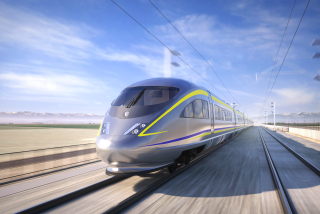Amtrak Again Asking for Permanent Funding
Congress again has been asked to establish a “dedicated funding source” to support Amtrak, the nation’s passenger rail operator.
In his annual budget request to the Senate Appropriations Committee, Amtrak President Graham Claytor asked the government for $712 million in funding and equipment purchase and improvement grants for fiscal 1989-90. That’s $132 million more than the current funding level. A decision may be forthcoming before Congress adjourns this summer.
Also, Claytor, in an effort to end his yearly “cap-in-hand” appeal to legislators, proposed--and not for the first time--that a special trust fund, supported by the gasoline tax, be established to maintain the passenger rail system in years ahead.
The money would go to Amtrak, and the federal government would not have to haggle each year over Amtrak financing.
Claytor’s proposal has been turned down before. Some observers believe, however, that his chances of trust fund approval improves every day.
Many transportation experts are attaching new importance to passenger train service, mostly because of what is happening in other modes of travel.
Many of our interstate highways, local roads and bridges are badly in need of upgrading. The federal government has acknowledged this.
Airports Jammed
Our airports are jammed. They need massive and rapid expansion to cope with the expected increase in volume.
It is in this environment that Claytor made his latest appeal for funding until such time as Amtrak might be able to make a profit. His reasoning, and that of other Amtrak boosters, is sound.
Trains are clean and energy-efficient, probably more so than any other mode of transportation. They are safe and reliable and relieve traffic pressure on freeways and airways.
Amtrak has become the nation’s sixth-largest carrier, trailing only four airlines and Greyhound buses. It transported 22 million people last year.
Amtrak’s survival will not be cheap. Track maintenance is costly. The rail operator’s major problem right now, however, is a chronic shortage of rolling stock.
Without equipment, expansion is impossible. Without expansion, Amtrak’s chances of getting by without a government subsidy are slim.
Expansion opportunities exist. Claytor said that six states are asking Amtrak to establish new routes. The states were turned down only because Amtrak had no trains available.
Opposition to Subsidies
No real expansion can be undertaken when Amtrak is dependent on the good will of Congress for its funding. There even have been times when some congressmen have called for an end to all Amtrak subsidies.
A certain irony exists in the proposal that the trust be funded by a gasoline tax. Those who pay the tax would be helping to build and expand an alternative transportation system.
They may find one day that such a system could whisk them to Southland cities in 125 m.p.h. comfort, far from the crush of freeway traffic.
Amtrak’s business has been improving. The rail operator’s passenger loads are up 20% in eight years.
Also, in that same period, Amtrak has reduced its dependency on government assistance from more than half of its costs to just 30% in the last fiscal year. So encouraging have the results been that a bill before Congress seeks binding government support.
The dozen senators who authored the bill said that such a commitment was necessary in the interests of “a balanced transportation system.”
With that kind of sentiment in Congress, with the states calling for new rail transportation services, and with no immediate end to the problems of our congested airports and freeways, Claytor’s call for permanent funding may finally be answered.
More to Read
Sign up for Essential California
The most important California stories and recommendations in your inbox every morning.
You may occasionally receive promotional content from the Los Angeles Times.










